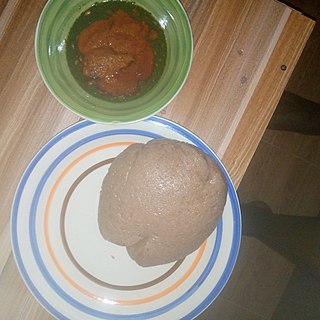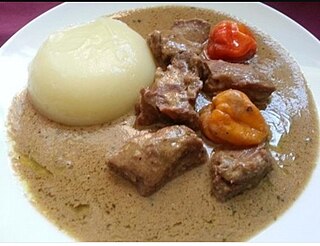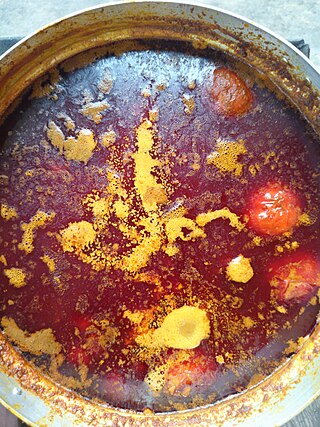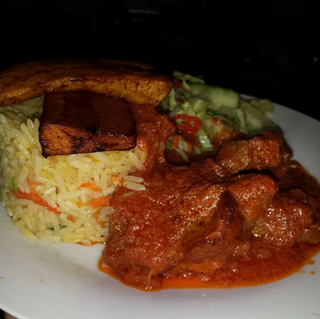
The cuisine of the Southern United States encompasses diverse food traditions of several subregions, including cuisine of Southeastern Native American tribes, Tidewater, Appalachian, Ozarks, Lowcountry, Cajun, Creole, African American Cuisine and Floribbean cuisine. In recent history, elements of Southern cuisine have spread to other parts of the United States, influencing other types of American cuisine.

Scotch bonnet is a variety of chili pepper named for its supposed resemblance to a Scottish tam o' shanter bonnet. It is ubiquitous in West Africa and the Caribbean.

Jambalaya is a savory rice dish of mixed origins that developed in the U.S. state of Louisiana apparently with African, Spanish, and French influences, consisting mainly of meat or seafood, and vegetables mixed with rice and spices. West Africans and Spanish people each had versions of jambalaya in their respective countries. Historian Ibraham Seck states Senegalese people were making jambalaya. The French introduced tomato to West Africans and they incorporated the food into their one-pot rice dishes that created jambalaya and jollof rice. Spanish people made paella which is also a one-pot rice dish cooked with meats and vegetables. These styles of cuisines blended in Louisiana and resulted in cultural and regional variations of the dish.

Àmàlà is a staple swallow food originating from Nigeria popularized by the Yoruba ethnic group of Southwestern Nigeria and other parts of Yorubaland. It is made of yam, cassava flour, or unripe plantain flour. Tubers of yams are peeled, sliced, cleaned, dried and then ground into flour. It is also called èlùbọ́. Yams are white in colour but turn brown when dried which gives àmàlà its colour. It is a popular side dish served with ewédú and gbẹ̀gìrì, but is also served with a variety of other ọbè(soups), such as ẹ̀fọ́, ilá, and ogbono.

Mulukhiyah, also known as mulukhiyya, molokhiyya, melokhiyya, or ewédú, is a type of jute plant and a dish made from the leaves of Corchorus olitorius, commonly known in English as jute, jute leaves, jute mallow, nalta jute, or tossa jute. It is used as a vegetable and is mainly eaten in Egypt, the Levant, Sudan, Cyprus, Libya, Tunisia and Algeria. It is called saluyot in the Philippines. Mulukhiyah is rather bitter, and when boiled, the resulting liquid is a thick, highly mucilaginous broth; it is often described as "slimy", rather like cooked okra. Mulukhiyah is generally eaten cooked, not raw, and it is either eaten chopped and sautéed in oil, garlic and cilantro like in Syria or turned into a kind of soup or stew like in Egypt, typically bearing the same name as the vegetable in the local language. Traditionally mulukhiyah is cooked with chicken or at least chicken stock for flavor and is served with white rice, accompanied with lemon or lime. In Tunisia, the dish is prepared with jute powder instead of the leaves and cooked with lamb or beef to be served with bread.

Ghanaian cuisine refers to the meals of the Ghanaian people. The main dishes of Ghana are centered around starchy staple foods, accompanied by either a sauce or soup as well as a source of protein. The primary ingredients for the vast majority of soups and stews are tomatoes, hot peppers, and onions. As a result of these main ingredients, most Ghanaian soups and stews appear red or orange.

Peanut stew or groundnut stew, also known as maafe, sauce d'arachide (French) or tigadèguèna is a stew that is a staple food in Western Africa. While maafe is a dish originating in Senegal, tigadéguéna originates from the Mandinka and Bambara people of Mali.

Fried plantain is a dish cooked wherever plantains grow, from West Africa to East Africa as well as Central America, the tropical region of northern South America and the Caribbean countries like Haiti to Cuba and in many parts of Southeast Asia and Oceania, where fried snacks are widely popular. In Indonesia it is called gorengan. It is called dodo in Yoruba in South West Nigeria, otherwise known as simply fried plantain in other parts of Nigeria. Kelewele is a fried spicy plantain or can be fried as a side dish for Red Red and fish stew in Ghana.

West African cuisine encompasses a diverse range of foods that are split between its 16 countries. In West Africa, many families grow and raise their own food, and within each there is a division of labor. Indigenous foods consist of a number of plant species and animals, and are important to those whose lifestyle depends on farming and hunting.

Nigerian cuisine consists of dishes or food items from the hundreds of Native African ethnic groups that comprises Nigeria. Like other West African cuisines, it uses spices and herbs with palm oil or groundnut oil to create deeply flavored sauces and soups.

Peanut soup or groundnut soup is a soup made from peanuts, often with various other ingredients. It is a staple in African cuisine but is also eaten in East Asia (Taiwan), the United States and other areas around the world. It is also common in some regions, such as Argentina's northwest, Bolivia and Peru, where it can sometimes be served with bone meat and hollow short pasta or fries. In Ghana it is often eaten with fufu, omo tuo and banku often very spicy. Groundnut soup is also a native soup of the Benin (Edo) people in Nigeria and it is often eaten with pounded yam. Some of the essential ingredients used in making it are: Ugu, Oziza leafs Piper guineense and Vernonia amygdalina.

Egusi sauce or Egusi Soup, traditionally Egusi or Obe Egusi in Yoruba, is a culinary sauce prepared with egusi seeds as a primary ingredient. Egusi seeds are the fat- and protein-rich seeds of certain cucurbitaceous plants. Egusi sauce is common and prevalent across Central Africa as mbíka, and may be served atop rice, cooked vegetables, or grilled meat, such as goat, chicken, beef, or fish. It may also be served atop fufu, omelettes, amala, and eba, among other foods. Egusi soup is also consumed in West Africa, sometimes with chicken.

Palm nut soup or banga is a soup made from palm fruit common in the Cameroonian, Ghanaian, Nigerian, Democratic Republic of Congo and Ivorian communities. The soup is made from a palm cream or palm nut base with stewed marinated meats, smoked dried fish, and aromatics. It is often eaten with starch, fufu, omotuo, banku, fonio, or rice. The use of the palm fruit in cooking is significant in Ivorian, Cameronian, Nigerian, Ghanaian, Liberian and other West and Central African cuisine.

Àbùlà is a soup of Yoruba people from Western Nigeria. It is typically eaten together with amala, but can be eaten with other swallow foods. Abula literally means a mixture of soups but is mostly associated with a mixture of gbegiri, ewedu and ọbẹ̀ata (stew).

Pounded yam or Iyán (Yoruba) or Ruam-Yo (Tiv) or "Akpu, Utara-ji or Nni-ji" (Igbo) is a Nigerian swallow or Okele food native to the Yoruba, Edo, Igbo Tiv and Ebira ethnic groups. It is a traditional food prepared by pounding boiled yam with a mortar and pestle. Pounded yam is similar to mashed potatoes but heavier in consistency. It is a smooth and tasty delicacy traditionally eaten with the hands.

Nkwobi is a delicacy commonly found in restaurants, it is otherwise known as nkwobi. The cuisine is common among the people of Igbo ethnic group. it is a soup made up of cuts from cow feet.

Obe ata (Yoruba) is a stew or sauce used in Yoruba cuisine and meals found in Nigeria, Benin and Togo. In concept, it is similar to that of French mother sauces: a sauce from which other sauces are made, or to the Mexican Mole. It can be used as the base with which Jollof rice is made, either at the initial or near prepared state. Rice, yam and bread are also eaten with it. In Nigerian cooking the sauce is "ubiquitous".

Yoruba cuisine is the numerous and diverse foods of the Yoruba people of Yorubaland. Some notable Yoruba food include : Ọ̀fadà, Àsáró, Mọ́í Mọ́í, Ẹ̀gúsí soup, Àbùlà, Àkàrà, Ilá Alásèpọ̀, Ẹ̀fọ́ rírò with Òkèlè, etc.

Ayamase, also spelled Ayamashe, is a special type of sauce or stew native to the Yoruba people in West Africa. It is eaten with Ofada rice and sometimes regular white rice. It is a made with peppers, green peppers and spices. It usually contains meat, fish and eggs. It has a dark greenish colour. It is different from a stew called Ofada sauce or Lafenwa stew which is reddish and also eaten with Ofada rice. It is popular in Yoruba parties called Owambe and in home cooking.

Ila Alasepo or ila asepo is a Yoruba Okro sauce/ stew, called soup in Nigerian English, eaten with Okele. Ila-Alasepo means "Okro cooked together". It involves an Okro sauce cooked with seafood and spices. It can also have meat and fish as well. Ila alasepo is similar to African Gombo or Sauce Gombo or Louisiana Gumbo. The dish can have the okro viscous or viscosity free. It is different from " Ila" which just means okro which in cooked Yoruba cuisine usually refers to a plain cooked okro or cooked with Iru separately cooked from a tomato-pepper based sauce called Obe-ata that it is eaten with alongsides Okele. Unlike ila, ila alasepo is cooked together and usually features seafood, meat and fish, with pepper, tomato, oil, onion, iru and other spices added in one pot. it can be called Obe Ila alasepo, Obe means Soup, Sauce or Stew in Yoruba.





















